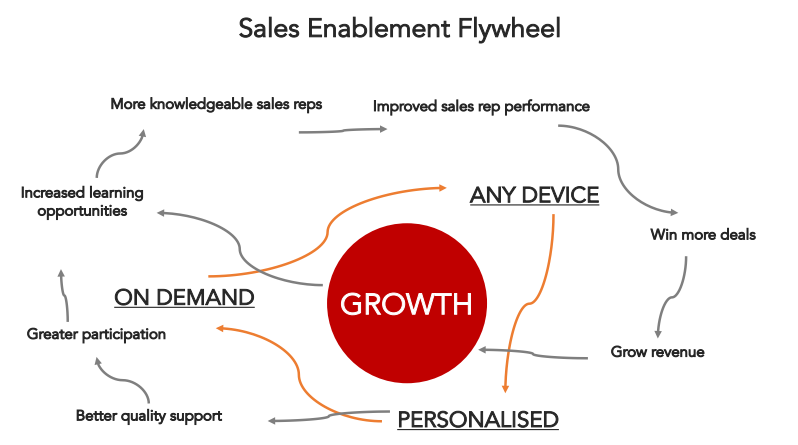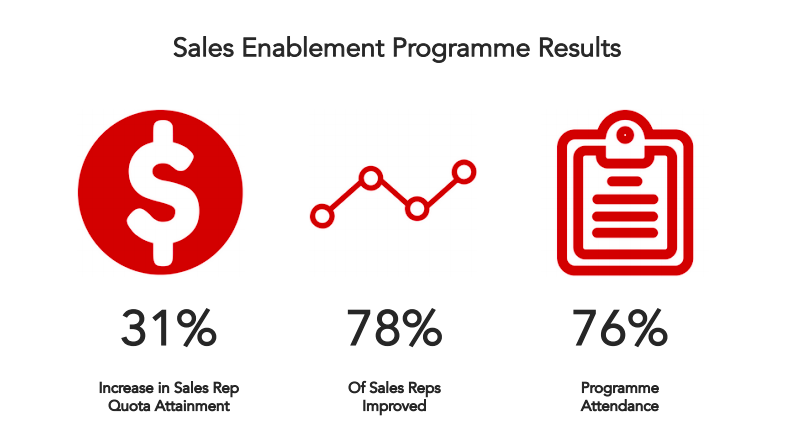In my sales enablement role at HubSpot I'm truly privileged to partner with over 100 sales professionals that are at the top of their game and only want to get better. Working with sales reps that want to succeed and push each other to do better is a joy.
Unlike other parts of the business, it’s relatively uncommon for sales enablement to reveal how they work with the sales organisation to hit quota and help the company to grow. I want to use this post to share how sales enablement at HubSpot arms sales reps for success, talk about the lessons learnt along the way, and most importantly, the results achieved. I’m confident there’s a bunch of actionable ideas you can apply at your own software as a service (SaaS) business.
Before we start, let me make one thing clear. I believe sales enablement has to be a driver of growth, rather than an expense or worse, an overhead. But for this to happen, the sales enablement function must carry a revenue goal. I speak with sales enablement leaders that are reluctant to even talk about, let alone carry a revenue goal. They’re plain wrong and this has to change.
Quite simply, if you don’t carry a revenue goal you’ll only ever play a supporting role. Revenue trumps all else and sales enablement has to contribute to that. As an aside I’ve heard some industry colleagues talk about how the sales enablement function should be a 'business within a business'. To me, this reeks of empire building, self-preservation and grandstanding. Crucially, this point of view fails to acknowledge the sales teams we’re seeking to partner with and enable. But that's a discussion for another day.
Let’s talk about how HubSpot equips it sales reps for success.
Why sales enablement programme delivery matters
I’m fortunate that in my role I get to speak with sales enablement professionals from all over the globe. I line up meetings each quarter with industry colleagues to learn about their goals and challenges, as well as hear about successes and failures and their technology stack.
From these meetings it’s clear they know why they’re running sales enablement programmes (they want to help their company grow), they also have a good grasp of what metric they want to improve (oftentimes it’s quota attainment or something similar) and they know the how (which inevitably means running a range of sales enablement programmes).
However, the when and where, or put another way, the programme delivery and execution is an ongoing challenge. This is really important, but often overlooked - it’s no use having the best plan and strategy in the world if the execution is terrible.
How people expect services to be delivered today
What does great sales enablement programme delivery look like? It's an important question that needs to be answered. Sales enablement programme delivery matters, but too often people get fixated on what’s happening within the business to business (B2B) space and neglect everything else. That’s a mistake and how sales enablement should be delivered today is not much different to how any product or service should be delivered. The answer is a lot closer to home, and in fact can be found in our homes.
Over the past decade the world has changed and with it, people’s expectations of how they can find information, interact with your product and service, has changed too. To see how people, and by proxy, I mean sales reps expect services to be delivered today, take a moment to evaluate where you spend your time.
Sales enablement professionals need to understand where people invest their time, on what device and how they consume information. 20 years ago people read newspapers, bought books and attended in-person training. While these are still important, there are many more ways for people to occupy their time, and sales enablement professionals need to be cognisant of this ever-changing landscape.
On demand, any device and personalised
Let’s take a step back and look at the trends which are shifting people’s expectation of service delivery. When you’re out and it’s time to go home, you open up your smartphone, click on the Uber or Lyft app and order a cab. The value of these services and the expectation is that they are available on demand. Or if you're staying in and want to catch up on a TV programme, you turn to Netflix. This service is available on your smartphone, TV, desktop and tablet - the expectation is that Netflix is deliverable across any device.
Thirdly, if you're listening to your favourite music on Spotify, you've come to expect personalised recommendations. Personalisation enhances your experience and provides a better, more tailored service - one that you’ll want to use time and time again.
The way I see it, if we're to truly meet the needs of sales reps, we must deliver a great experience. And in today’s context that means on demand, across any device, and personalised. Sales enablement professionals need to adapt to these trends and use them as pillars for programme delivery.
Create a flywheel of growth
Now let’s look at why providing sales enablement that is available on demand, across any device and personalised is important. It’s good if a company provides these elements individually, but it’s great when they’re provided together. In fact, do these elements together and do them well, and you can create a flywheel effect that enables your sales reps, and by extension your company to grow. While Amazon is perhaps the best example of the flywheel strategy, the principles can be applied to sales enablement.
Let me explain. On demand, any device and personalised are three elements of great sales enablement delivery. If you're providing on demand sales enablement, you're going to increase opportunities for sales reps to learn. If you do that successfully, it stands to reason you'll have more knowledgeable sales reps. And if your sales reps are upskilling and learning more, their performance is going to increase too, and increased sales rep performance leads to winning more deals, which in turn leads to greater revenue.
Then if you're also providing sales enablement that is personalised, you're going to create a better quality service for sales reps to leverage. That's going to mean greater participation and engagement with your sales enablement programmes, which in turn leads to increased learning opportunities, and the cycle repeats itself. Do on demand, any device and personalised well and you can create a flywheel effect.
Like all flywheels, it takes time and effort to begin spinning, however once it’s starts, it creates momentum of its own, which makes it easier to spin. Each improvement whether that be to on demand, on any device or personalised fuels the flywheel and accelerates the company’s cycle of growth. Importantly, the ideas of on demand, across any device and personalised are enduring - tactics and technology may change, but these core tenets will consistently resonate with sales reps.
However, there is a caveat to all of this. To create a flywheel your sales enablement tactics, content, and programme management must be great too. If these are poor you’ll see poor results.
How HubSpot Ensures Sales Rep Success
Here are three key sales enablement plays we execute at HubSpot so sales reps can close more deals:
1. Deal support
We spoke with sales reps to understand how sales enablement can support them more effectively. It became clear that they need support available in the moment, during a deal. Taking a deep dive on a deal after it was lost was not considered helpful. In short, sales reps told us they want in-deal, on demand support and counsel.
To meet this need we created a deal support programme consisting of on demand, one-to-one support for sales reps to close deals. It has three parts consisting of deal strategy, competitive intelligence and customer reference calls. Deal strategy is when we sit down with a sales rep and figure out how best to approach the deal and build a strategy to win.
We provide on demand competitive intelligence if sales reps want to know how to position HubSpot against a competitor or talking points to overcome an objection. We also set up many customer reference calls, where we put a prospect in touch with a client who is from the same industry, region, or overcame a similar marketing challenge.
How does deal support works at HubSpot?
When I tell other sales enablement professionals about deal support at HubSpot, they almost always want to know more about the process. So allow me to explain.
We set up a large number of customer reference calls between clients and prospects - nobody from HubSpot joins the call. They are an opportunity for a prospect to speak candidly with a client and learn about what it takes to be successful with HubSpot. We typically arrange customer reference calls once a demo has taken place as we consider them a tool to be leveraged 'when the finish line is in sight'. However, deal strategy and competitive intelligence is available to sales reps at nearly any stage of a deal.
How do sales reps request deal support? We're fortunate at HubSpot to have a wiki full of great resources for sales reps. In the first instance, sales reps go to the wiki to try and find out the answer to their question. However, if the question is more nuanced or it's a particularly challenging situation, sales reps complete a Google form or use our Slack channel to request one-to-one deal support.
We’ve seen so much success with deal support that we’ve doubled down on it. So far the programme has supported over 100 deals and helped close more than $1 million in annual recurring revenue (ARR), with a win rate of 60%. But here's the thing. Deal support is just another tool. It's not a silver bullet for sales. It's not going to help win every single deal, but it's just another valuable tool in a HubSpot sales rep's toolkit.
2. Mobile learning
The second way HubSpot equips sales reps to succeed is by making mobile learning a reality. Many companies talk the talk on mobile, but in my experience, rarely walk the walk. Sales reps told us they want the option to be able to learn from anywhere, whether that be in the office, at home or on the way to work.
“Option” and “anywhere” are the important words here - sales reps want the ability to be able to learn from anywhere, if they so wish. This is by no means mandatory, but many sales reps at HubSpot don’t necessarily work a nine-to-five job - they fit work around their schedule, which can mean working away from the office.
Once we received this feedback from the sales organisation we set about finding the right platform, and after a rigorous evaluation process teamed up with a company called Qstream. They provide fantastic software that enables sales reps to learn on their smartphone, in their browser, or on a tablet.
We ran a trial to help sales reps increase their understanding of the competitive landscape. Before I mention the results achieved, I want to say that one of the most attractive things about Qstream is that it takes little effort on the part of sales reps. The commitment was minimal - just two minutes every other day to answer two multiple choice questions, all on a platform of the sales reps’ choice.
And the results achieved were impressive. Over 90% of sales reps used the software. Speak to any sales enablement or learning and development (L&D) professional and they will tell you that achieving 90% engagement for any type of programme is almost unheard of. Not only did sales reps participate, but they increased their knowledge retention by 11%. But most importantly, we saw an uptick in competitive win rate, plus positive anecdotal feedback regarding how equipped sales reps felt for competitive deals.
3. Personalised training
At HubSpot we also provide personalised training for sales reps. Just think about when you go to a coffee shop and you get that personalised drink you want. Whether people are buying a coffee, listening to music or using sales enablement they now expect a personalised experience.
We spoke with our sales reps and they confirmed it - training and sales enablement is more effective when it's tailored. We've all sat in a training session where you're bored and not listening. That's because the training has not been tailored to your specific needs. Training like that, suits an L&D organisation and is good for compliance, but it does not meet the needs of sales reps.
To provide personalised training we identified a cohort of sales reps that averaged under 95% quota attainment and provided them with an eight week intensive bootcamp. It consisted of training, deal support and most importantly, it was heavily personalised to their needs. We also A/B tested the programme - one group was invited to join and another were not.
Setting up a personalised training programme
I want to dig in a little more to the principles of the training programme and explain what it was and just as important, what it wasn't. Sales reps told us what kind of training they like and respond well to. Overwhelmingly, their preference was for whiteboard and coaching-led training, rather than PowerPoint or Google Slide-led lectures. We actually imposed a five slide limit to ensure subject matter experts were not overly reliant on slides.
We also wanted the training to be very much like a question and answer session. So we had a Q&A running throughout, rather than waiting for questions at the end of the session. Subject matter experts were recruited to deliver each session, with a brief to coach instead of lecture. In short, we created a programme that was practical, tailored, agile, and focussed on small groups.
The results were as dramatic as they were pleasing. Personalised training improved sales performance significantly - we saw an 31% increase in sales rep quota attainment, while, 78% of reps improved and attendance was 76%. We were delighted with these results and it’s safe to say it had a material impact on revenue at HubSpot. In terms of the A/B test, the other group improved by 9% during the same period.
How to arm your sales reps for success
If you want to equip your sales reps for success, there’s three steps to follow:
Evaluate how you deliver sales enablement programmes today.
Think in terms of on demand, across any device and personalised.
Seek out opportunities to create a flywheel of growth.
Every company is unique and the makeup of each sales organisation will always be different. However, by following the steps and spending time answering these questions, you’ll give yourself the right foundation to arm your sales reps for success and deliver sales enablement programmes that improve performance and drive revenue.







